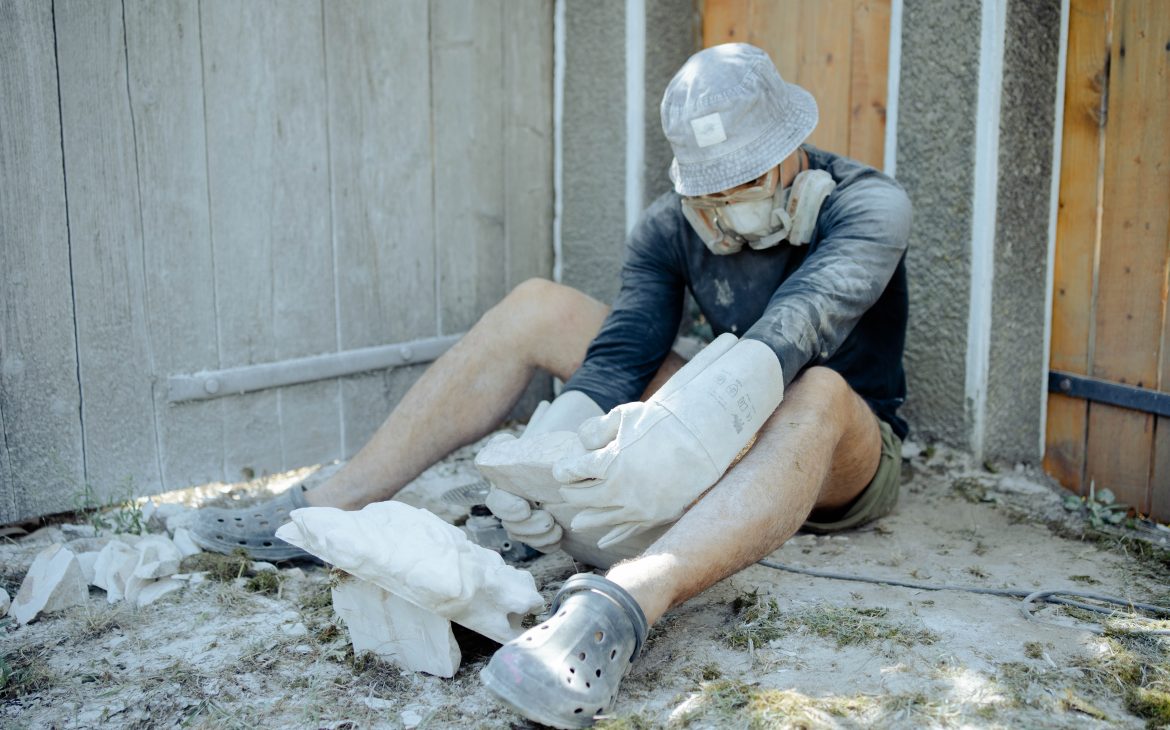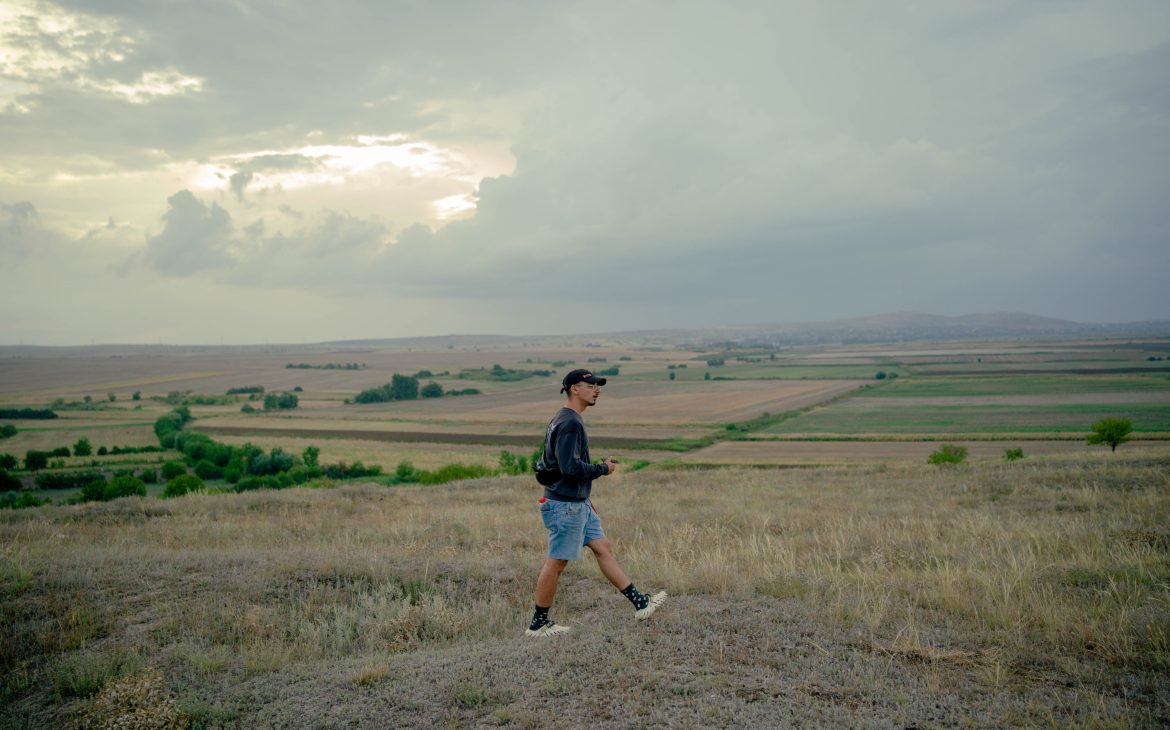Matei Emanuel is an emerging visual artist who studies and works in Bucharest. His artistic practice involves formulating social ironies through objects made from various materials and techniques. The artist aims to introduce works with mass-produced aesthetics into an art world where sophisticated values and expectations discredit the appreciation of a comic attitude. In the month of September, Matei continued his artistic endeavor of natural surprise of the everyday that started last year in the residence. Back in the “carving workshop” in front of the gate, appreciating the sensoriality of the stone during two residency editions meant recognizing the tactile and chromatic attributes of the stone and its sound qualities during processing.
This year Matei Emanuel’s works could be seen in various exhibitions organized in Bucharest and in the country, among which we mention: “Mulberries and Elderflower”, Pharmakon, Bucharest, 2024; “Les fleurs du mal” Constanta Art Museum, Constanta, 2024; “Squeeze your eyes”, Bistrita-Năsăud Museum Complex, Bistrița, 2024; “Should you let me cross the border?”, 1 Square Meter of Art, Eforie Sud, 2024; “A heap of broken images”, Leilei Gallery, Bucharest, 2024; RAD fair 2024, represented by Catinca Tăbăcaru Gallery and Cazul 101 Gallery, Bucharest, 2024; “Garden of Forking Paths”, Sector 1 Gallery, Bucharest, 2024; “Cei noi / Graduate Curated”, Museum of Recent Art, Bucharest, 2024; “Proud to be a Human Animal”, Case 101, Bucharest 2024;
These seven questions were designed to reveal how the interactions with the natural environment and with the locals of a rural community influenced the creation and interdisciplinary perspectives of a young artist participating in the Art and Anthropology Residency in Luncavița (Tulcea).
Dana Pârvulescu: Tell me a few words about yourself, your artistic practice, and your artistic process during the residency.
Matei Emanuel: I am a visual artist who works in Bucharest. My artistic practice involves formulating social ironies through objects made of various materials and techniques. I am focusing on introducing works with a mass-produced aesthetic into an art world where sophisticated values and expectations discredit the appreciation of a comic attitude.

D.P.: What were your expectations before starting residency, and how have they changed along the way?
M.E.: Having also participated in the first edition of the residency, I had some idea about the dynamics of the project and what I wanted to achieve during that period. This helped me a lot in the artistic process. Already knowing the key elements, I was not taken by surprise, but I managed to deepen certain particularities related to life in Luncavița and, at the same time, to complete the meticulous production process of stonework.
D.P.: What impact has the local community had on your art? Have you interacted with the locals or integrated elements from their everyday proximity in your works?
M.E.: I interacted with the locals and experienced various activities specific to the place together with them, but without directly integrating these aspects into my work. However, the sculpture I made in the residency is inspired by the attitude towards animals that I could observe in some locals. Costică, the rooster in the courtyard of the residence, is the subject of this work because he lives free from the threat that someone will think about the taste of his meat and grows old with his companions in the garden without being seen as a resource.

D.P.: What did you learn from the interactions with the flora and fauna of Dobrogea? Is there a story or incident that marked you and that you have translated into your works?
M.E.: During my residency in 2023, I was left with the impression that with the destruction of the Luncavița pond through the damming of the Danube, the fishing activity practised until then by most of the locals also came to an end. This year, I explored this phenomenon further. I concluded that although the drying up of the pond has been devastating in terms of fish abundance, fishing activity is still present among the locals. Together with one of the neighbors, I braved the unfriendly roads to reach the fishing spots known by him, and even if the results were not commensurate with our efforts, I remained determined to return to the banks of the Danube as soon as possible.
D.P.: What is the source of your interest in interdisciplinary projects?
M.E.: In my artistic practice, I often approach political and social topics, which naturally brings about my interest in interdisciplinarity. By being close to different anthropologists, the present project helped me to get closer and understand their thought processes

D.P.: How did this experience change your perspective on the artist’s role in a rural space?
M.E.: This experience proved to me that, although the cultural phenomenon is little present in the rural space, people in these communities are eager to discover and understand contemporary art.
D.P.: How will you use the experiences from the residency in your future artistic projects?
M.E.: In future artistic projects, I want to address themes related to the attitude of mastery over nature and the universe that is still present in contemporary society. Thus, the phenomenon of damming the Danube, together with the effects observed in residences in Luncavița, will represent relevant examples for my artistic approach.
D.P.: What plans do you have for this fall? Are we going to see you somewhere, and if so, where?
M.E.: My main concern is the realization of the dissertation project that I will defend at the end of this academic year.
Cover photo: Matei Emanuel. Image credit: Matei Rădulescu.




